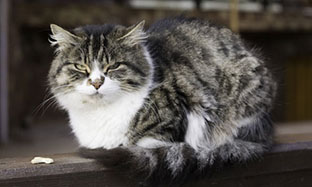 (1) (1).jpg)
Understanding Common Cat Skin Infections
Cats are known for their meticulous grooming routines, but when your furry friend starts experiencing skin problems, it can be a cause for concern. Feline skin conditions can range from mild to severe, impacting both the cat and its owner. Various factors, including parasites, allergies, and geographical location, contribute to the prevalence of cat skin infections. Understanding the causes, symptoms, and treatments for these conditions is crucial for providing proper care to your beloved pet.
Cat Skin Infection Causes
A cat's lifestyle, gender, and breed can influence the likelihood of developing skin issues. Outdoor cats face a higher risk of infestation by external parasites like fleas, and they may also be prone to injuries and abscesses from territorial disputes. Male cats, exhibiting more aggressive behaviour, are at an increased risk of bite wound-induced abscesses. Identifying these risk factors is essential for preventing and managing cat skin problems.
Recognizing Cat Skin Conditions
Recognizing the symptoms of cat skin infections is vital for timely intervention. Common signs include hair loss, excessive grooming, and the presence of red, scaly, or scabby areas on the skin. Fleas and ticks may also be visible on the cat's skin and coat. Flea dirt which is nothing but flea faeces made of dried blood is most common sign of a flea infestation, particularly along the spine where it is easy for fleas to land. Additionally, if your cat shakes its head excessively, it could indicate an issue with the ears. Regular grooming sessions provide an opportunity to identify these signs and seek veterinary assistance promptly.
Fungal vs. Bacterial Skin Infections in Cats
Cat skin infections can be categorized as fungal or bacterial, each requiring specific treatment approaches. Bacterial infections, known as pyoderma, often result from underlying conditions like allergies or parasitic infestations or secondary to untreated wound/deep scratches inflicted during cat fights. Superficial and deep pyodermas present with pus discharges and inflammation on the skin's surface or deeper layers. Treatment involves antibacterial medications, ideally a combination of both topical or systemic treatments are preferred, for a dual action.
Fungal infections, often manifest as ringworm. This contagious and zoonotic disease causes hair loss, crusty and scaly skin, and a characteristic circular rash resembling a ring. Antifungal medications, including topical creams and shampoos, effectively treat most cases. Severe infections may require systemic oral antifungal medications as a last resort.
Eruptions on the skin on account of food allergies or allergies to cleaning agents referred to as ‘contact allergy’ is quite commonly observed in cats. An autoimmune skin disease called “Pemphigus foliaceus” is seen in cats wherein crusts and ulcers develop around the eyes, ears, footpads and nose.
Cat Skin Infection Treatment
Proper treatment is essential for managing cat skin infections. Antibacterial medications are effective against bacterial infections, while antifungal treatments target fungal issues. In cases where both infections coexist due to an underlying condition, comprehensive treatment is necessary. Topical treatments may suffice for milder cases, but a combination of topical & systemic medications and supplements are essential for severe conditions for speedy results.
Most skin diseases have similar outward signs and hence avoid self-diagnosis and self-treatment. Always consult your vet. Ensure medications for dogs are not used for cats (unless advocated by your vet), since several medications that are registered for usage in dogs, may be toxic to the highly sensitive cat species.
Cat Skin Care and Prevention
Maintaining cat skin health involves regular grooming, parasite prevention, and addressing underlying issues. Ensuring indoor and outdoor cats receive appropriate care tailored to their lifestyles is crucial. Regular veterinary check-ups can aid in early detection and prevention of skin problems. Additionally, an animal protein-rich diet, supplementation with omega-3 & omega-6 fatty acids and essential vitamins and minerals and proper hygiene contribute to overall feline well-being.
To Conclude
Understanding common cat skin infections empowers cat owners to provide the best possible care for their feline companions. By recognizing symptoms early, seeking prompt veterinary attention, and implementing appropriate treatments, you can ensure your cat enjoys optimal skin health and overall well-being.
- The Best Cat Toys for Kittens and Adult Cats
- Senior cat ; What nutritional needs for my senior cat?
- Help protect your cat against harmful diseases
- Decoding Your Cat's Behaviour
- Senior cat ; What nutritional needs for my senior cat?
- Decoding Your Cat's Behaviour
- The Best Cat Toys for Kittens and Adult Cats
- Help protect your cat against harmful diseases


